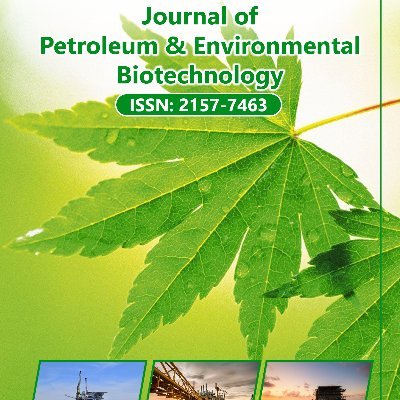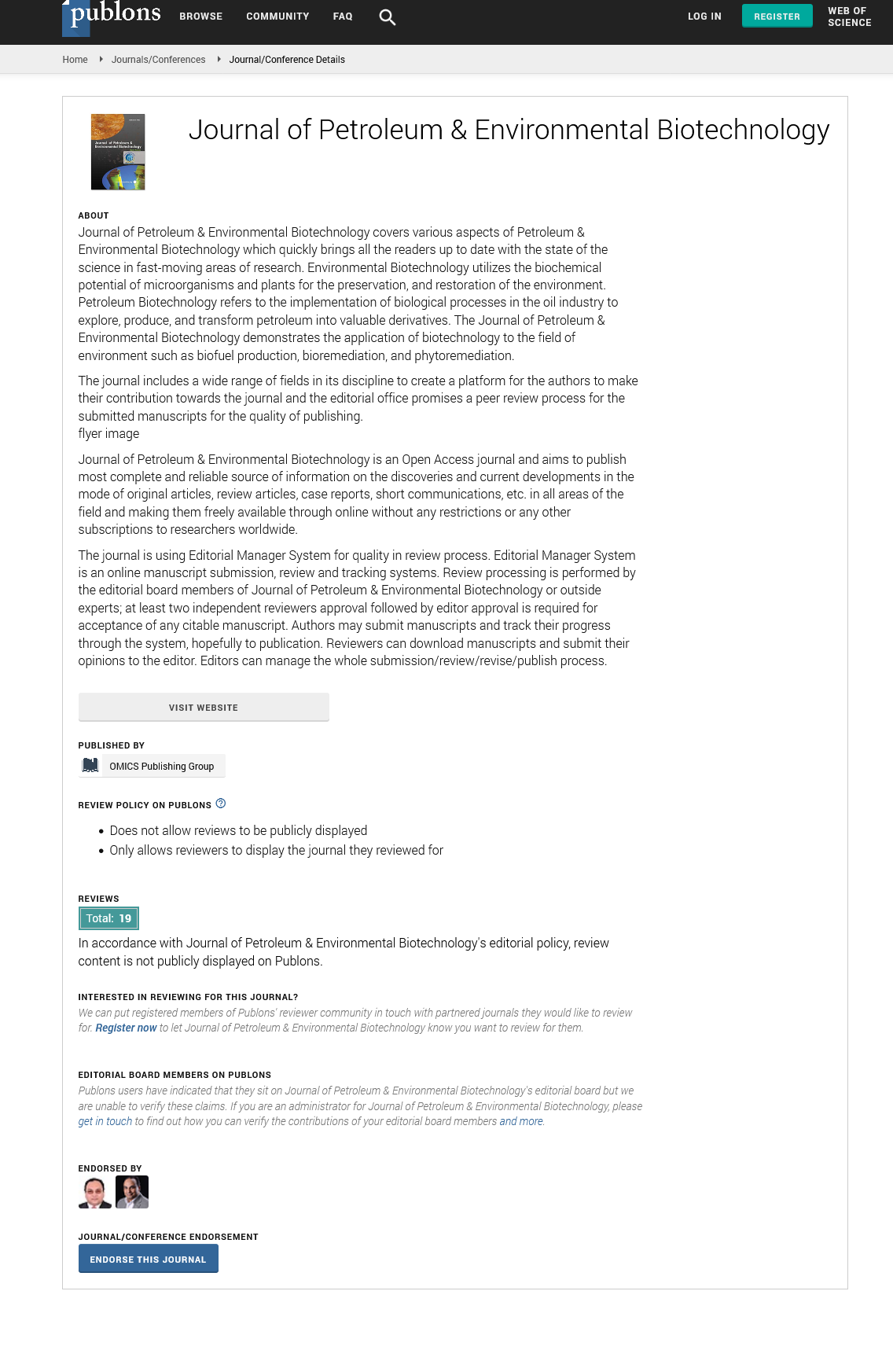Indexed In
- Open J Gate
- Genamics JournalSeek
- JournalTOCs
- China National Knowledge Infrastructure (CNKI)
- Electronic Journals Library
- RefSeek
- Hamdard University
- EBSCO A-Z
- OCLC- WorldCat
- SWB online catalog
- Virtual Library of Biology (vifabio)
- Publons
- MIAR
- Euro Pub
- Google Scholar
Useful Links
Share This Page
Journal Flyer

Open Access Journals
- Agri and Aquaculture
- Biochemistry
- Bioinformatics & Systems Biology
- Business & Management
- Chemistry
- Clinical Sciences
- Engineering
- Food & Nutrition
- General Science
- Genetics & Molecular Biology
- Immunology & Microbiology
- Medical Sciences
- Neuroscience & Psychology
- Nursing & Health Care
- Pharmaceutical Sciences
Articles published in Journal of Petroleum & Environmental Biotechnology have been cited by esteemed scholars and scientists all around the world. Journal of Petroleum & Environmental Biotechnology has got h-index 39, which means every article in Journal of Petroleum & Environmental Biotechnology has got 39 average citations.
Following are the list of articles that have cited the articles published in Journal of Petroleum & Environmental Biotechnology.
| 2024 | 2023 | 2022 | 2021 | 2020 | 2019 | 2018 | 2017 | 2016 | 2015 | 2014 | 2013 | 2012 | 2011 | 2010 | |
|---|---|---|---|---|---|---|---|---|---|---|---|---|---|---|---|
Total published articles |
40 | 56 | 60 | 53 | 18 | 16 | 31 | 38 | 61 | 57 | 35 | 43 | 34 | 12 | 4 |
Research, Review articles and Editorials |
3 | 15 | 10 | 13 | 8 | 11 | 1 | 35 | 53 | 53 | 30 | 33 | 21 | 8 | 4 |
Research communications, Review communications, Editorial communications, Case reports and Commentary |
20 | 41 | 50 | 40 | 10 | 5 | 30 | 3 | 8 | 4 | 5 | 10 | 13 | 4 | 0 |
Conference proceedings |
23 | 8 | 5 | 14 | 5 | 0 | 100 | 168 | 168 | 118 | 175 | 188 | 89 | 0 | 0 |
Citations received as per Google Scholar, other indexing platforms and portals |
488 | 589 | 699 | 790 | 653 | 601 | 563 | 460 | 389 | 349 | 171 | 70 | 20 | 36 | 0 |
| Journal total citations count | 5903 |
| Journal impact factor | 1.72 |
| Journal 5 years impact factor | 2.78 |
| Journal cite score | 20.15 |
| Journal h-index | 39 |
Important citations
Ulloa?Benítez, Á., Medina?Romero, Y.M., Sánchez?Fernández, R.E., Lappe?Oliveras, P., Roque?Flores, G., Duarte Lisci, G., Herrera Suárez, T. and Macías?Rubalcava, M.L., 2016. Phytotoxic and antimicrobial activity of volatile and semi?volatile organic compounds from the endophyte Hypoxylon anthochroum strain Blaci isolated from Bursera lancifolia (Burseraceae). Journal of applied microbiology, 121(2), pp.380-400.
Strobel GA. Methods of discovery and techniques to study endophytic fungi producing fuel-related hydrocarbons. Natural product reports. 2014;31(2):259-72.
Hassan SR, Strobel GA, Geary B, Sears J. An endophytic Nodulisporium sp. from Central America producing volatile organic compounds with both biological and fuel potential. Journal of microbiology and biotechnology. 2013;23(1):29-35.
Strobel G. The emergence of endophytic microbes and their biological promise. Journal of Fungi. 2018 Jun;4(2):57.
Ebru UY, YALÇIN HT. Mikrobiyal Biyosürfaktanlar. Türk Bilimsel Derlemeler Dergisi. 2013;6(2):93-102.
Jameel AA, Haider NH. DETERMINATION OF THE OPTIMUM CONDITIONS FOR BIOSURFACTANT PRODUCTION BY LOCAL ISOLATE OF LACTOBACILLUS PLANTARUM AND EVALUATE ITS ANTIMICROBIAL ACTIVITY.
Sharma D. Commercial Production, Optimization, and Purification. InBiosurfactants: Greener Surface Active Agents for Sustainable Future 2021 (pp. 79-113). Springer, Singapore.
Qin Z. Production of Heavy Oil Liamocins by Aureobasidium pullulans (Doctoral dissertation, The Ohio State University).
Astuti DI, Purwasena IA, Priharto N, Ariadji T, Afifah LN, Saputro RB, Aditiawati P, Persada GP, Ananggadipa AA, Abqory MH, Amaniyah M. Bacterial community dynamics during MEOR biostimulation of an oil reservoir in sumatera Indonesia. Journal of Petroleum Science and Engineering. 2022 Jan 1;208:109558.
Muneeswari R, Swathi KV, Sekaran G, Ramani K. Microbial-induced biosurfactant-mediated biocatalytic approach for the bioremediation of simulated marine oil spill. International Journal of Environmental Science and Technology. 2021 Jan 4:1-4.
Alkhalaf SA, Ramadan AR, Obuekwe C, El Nayal AM, Abotalib N, Ismail W. Heavy Vacuum Gas Oil Upregulates the Rhamnosyltransferases and Quorum Sensing Cascades of Rhamnolipids Biosynthesis in Pseudomonas sp. AK6U. Molecules. 2021 Jan;26(14):4122.
Dange SS, Gulve RM, Deshmukh RB, Jadhav PV, Marathe RJ, Phatake YB, Dange SR. Biosurfactant: process optimization by classical one parameter at a time approach. Research Journal of Biotechnology Vol. 2020 Sep;15:9.
Karbalaei-Heidari HR, Taghavi L, Hasanizadeh P. Functional Evaluation and Physicochemical Characterization of a Lipopeptide Biosurfactant Produced by the Stenotrophomonas sp. IE-93. Iranian Journal of Science and Technology, Transactions A: Science. 2019 Aug;43(4):1447-55.
Rahman PK, Sekhon Randhawa KK. Commentary: Oil degradation and biosurfactant production by the deep sea bacterium Dietzia maris As-13-3. Frontiers in microbiology. 2016 Jan 12;6:1557.
Ambaye TG, Vaccari M, Prasad S, Rtimi S. Preparation, characterization and application of biosurfactant in various industries: A critical review on progress, challenges and perspectives. Environmental Technology & Innovation. 2021 Nov 17:102090.
Suryawanshi Y, Kaur G, Mandavkar A, Jena B. Biosurfactants from Soil Microorganisms as a Possible Detergent Replacement. International Journal for Research in Applied Sciences and Biotechnology. 2021 Jun 8;8(3):136-43.
Gudiukaite R, Nadda AK, Gricajeva A, Shanmugam S, Nguyen DD, Lam SS. Bioprocesses for the recovery of bioenergy and value-added products from wastewater: A review. Journal of Environmental Management. 2021 Dec 15;300:113831.
Dailin DJ, Abd Malek R, Selvamani S, Nordin NZ, Tan LT, Sayyed RZ, Hisham AM, Wehbe R, El Enshasy H. Yeast Biosurfactants Biosynthesis, Production. Microbial Surfactants: Volume I: Production and Applications. 2021 Nov 30:196.
Karpenko IV. Biotechnology of rhamnolipid surfactants of pseudomonas sp. PS-17 and their application to oilseeds.
JIANG L. Phytoinhibition and Formulation of Allelopathic Extract of Mikania micrantha Kunth ex HBK as pre-emergent weed suppressant against Echinochloa colona (L.) Link (Doctoral dissertation, Doctoral Thesis, Universiti Putra Malaysia, 2018.[Google Scholar]).

